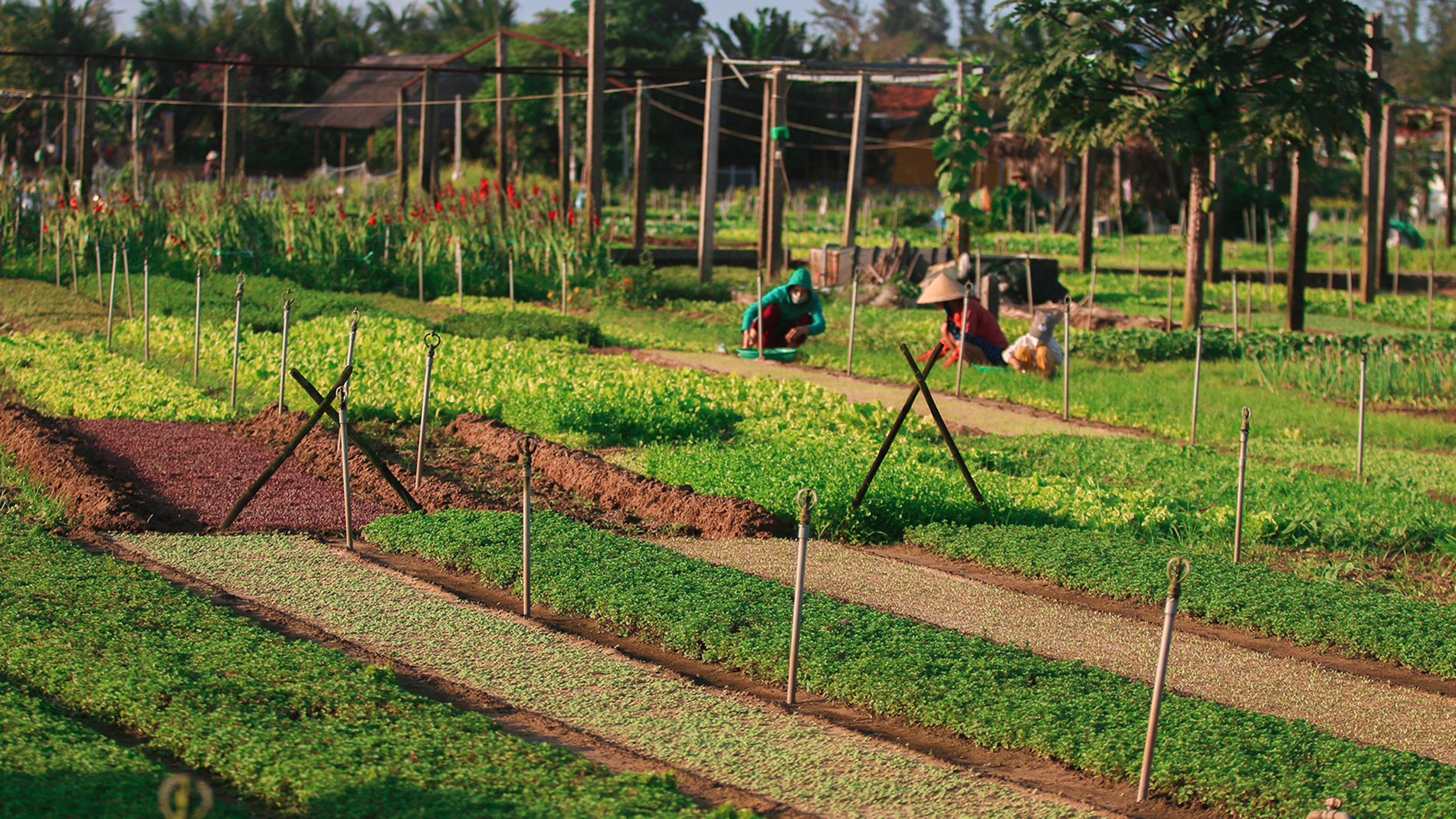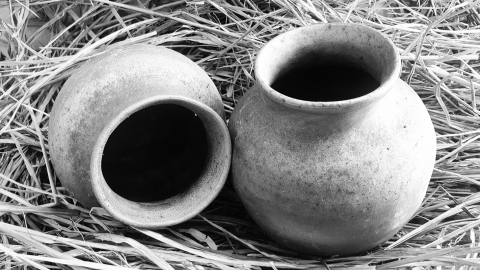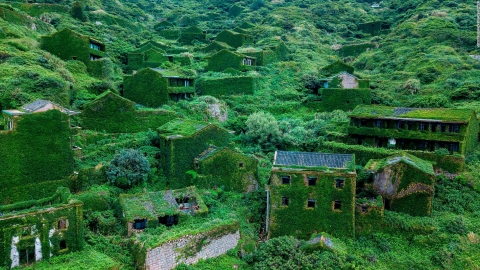Green vegetables are indispensable ingredients in traditional dishes of Hoi An ancient town, Quang Nam. Lettuce, basil, fish mint, ... mixed with Quang noodles, golden cao lau in thick broth; spicy Vietnamese coriander mixed with crispy rice paper in Cam Nam mussel salad; cool mustard greens rolled in crispy banh xeo. The flavor of the Central region melts on the tip of the tongue, making many people exclaim when enjoying. Connoisseurs all realize that green vegetables in Hoi An dishes have a very special flavor.
“The vegetables are from Tra Que village, and their fragrance is rarely found anywhere else” - the restaurant owners, with their unmistakable Quang Nam accent, proudly introduce to their guests the gift that heaven and earth have given them. What makes Tra Que vegetables different? This question has prompted many curious diners to go to the place where the vegetables are grown and harvested to find the answer.
SEE CHILDHOOD IN THE VEGETABLE PILLS
About 3.5 km from the center of Hoi An city, Tra Que vegetable village belongs to Cam Ha commune, surrounded by De Vong river and Tra Que lagoon. All four seasons of the year, the village is covered in a green color and filled with fragrance. The spicy smell of onion leaves, the pungent taste of basil, the bitter scent of bitter herbs... sometimes overwhelming and passionate at the tip of the nose, sometimes wafting in the wind enough to linger.
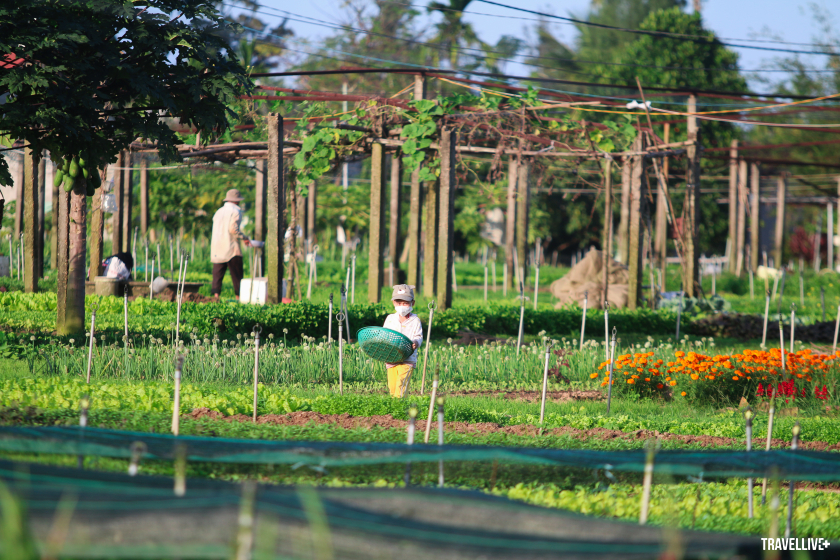
Tra Que village is located in Cam Ha commune, Hoi An, Quang Nam.
Discovered 400 years ago, Tra Que village was originally named Nhu Que because the place was filled with the scent of plants like cinnamon. At the beginning of the 18th century, a Nguyen king visited the village and enjoyed the dishes. Among the vegetables, the king was particularly impressed with a type that had a spicy taste like cinnamon and a fragrant scent like camellia, so he changed the village's name to Tra Que. Since then, the name Tra Que has been with the village until now.

Most of Tra Que people live by vegetable production and trading.
Like many other rural areas, every corner of Tra Que village has a simple color. There are small huts with old brick walls - where working tools are placed, where farmers rest and drink water; there are hoes, shovels, watering cans lying tilted between the rows after hours of hard work.
Like many other rural areas, each new day in Tra Que begins with gentle sunlight piercing the hazy mist, the crowing of roosters tearing apart the quiet atmosphere. Adults go to the fields to water and catch worms for vegetables; children ride their bicycles to school, clear laughter on the village roads piercing through the lush green. When the afternoon falls, in the distance, the conical hats of farmers are bobbing up and down in the green; children as young as four or five years old happily follow their mothers to the garden. In the distance, each turn of a bicycle or wheelbarrow carries the fruits of labor home, to the market.
Perhaps, many people see their childhood there, on the green vegetable beds.
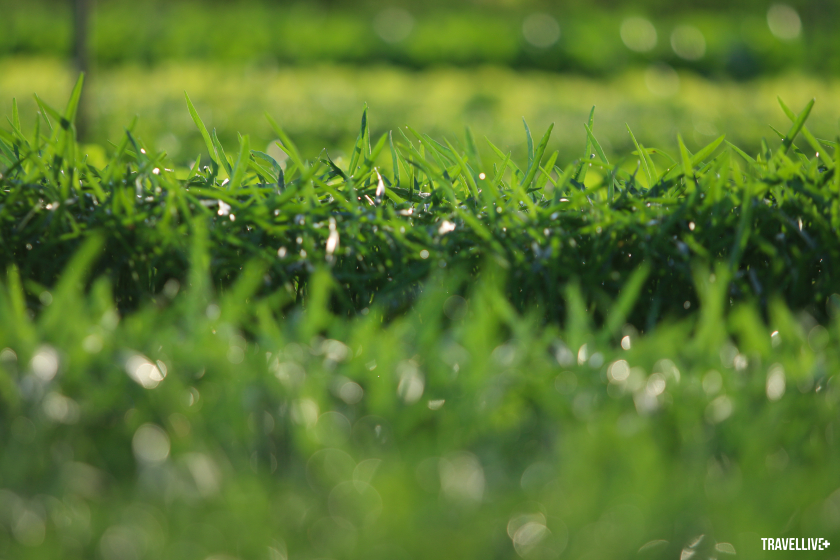
WHAT MAKES CINNAMON TEA FLAVOR?
Hundreds of years ago, Tra Que people were only fishermen, living off shrimp and fish. Gradually, fishermen discovered the alluvial soil, sandy soil, surrounded by rivers and lagoons providing water all year round, along with a cool, mild climate suitable for growing vegetables. They began to plant the first vegetables in the soil, then expanded the scale of cultivation and maintained it to this day as a traditional profession. After 300 years of growing vegetables, the cultivation techniques passed down from generation to generation have helped make Tra Que vegetables famous for their delicious flavor.
Locals say that the white sandy soil makes Tra Que vegetables pure and clean, and the new source of nutrients is the secret behind the special aroma of the vegetables.
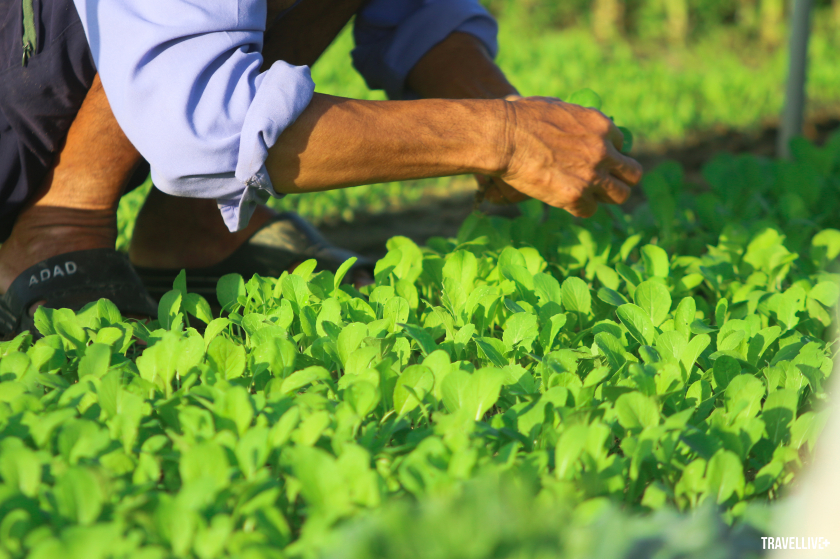
For hundreds of years, people have been collecting seaweed from Tra Que lagoon and Thu Bon river every day to fertilize the soil. The seaweed decomposes quickly and provides high nutrition, giving vegetables a special aroma that cannot be found anywhere else. When the demand for nutrition for vegetables is increasing, the seaweed source is not enough, people still do not use chemical fertilizers but use manure and cow dung to increase soil fertility. The manual farming method, completely without using chemicals, and the closed process makes Tra Que not only produce clean, fresh products but also absolutely protect the environment.
Seen from above, the village with 40 hectares of cultivated land is divided into square vegetable beds of different shades of green. Each bed is about 1 meter wide, separated by small paths. Looking at the neat, straight rows of vegetable beds is enough to imagine the meticulous hands of the farmers day after day, rain or shine. About 40 different types of green vegetables are grown here, including many typical types such as lettuce, perilla, basil, fish mint, onions, bitter vegetables..., when mixed together, they will have the five flavors of spicy, salty, sweet, bitter, and astringent that are indispensable in meals.
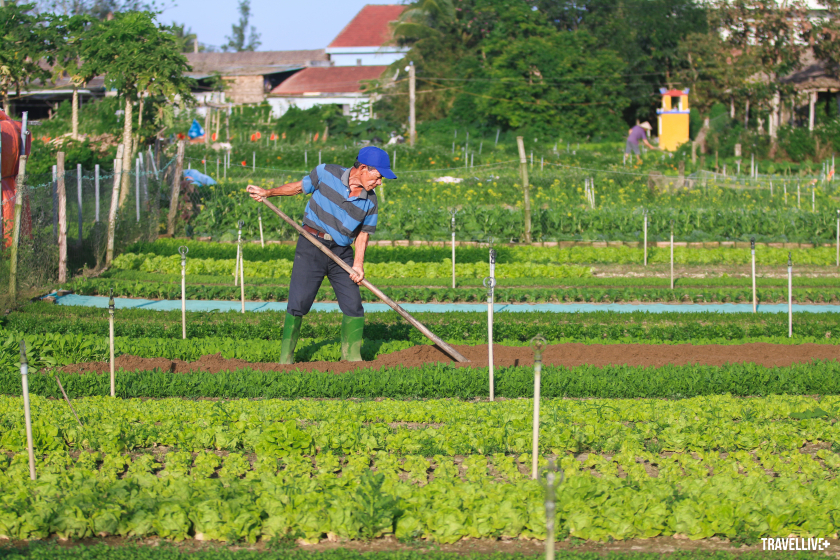
Tra Que village has nearly 300 households. Of these, about 200 households participate in vegetable production. Households are divided land area depending on the number of people. Vegetables are grown in two crops: winter crop from November to March, and summer crop from May to November every year.
Taking care of vegetables seems easy but is not simple at all. Mr. Le Van Bay (a resident of Tra Que village) said that because the sandy soil absorbs water quickly, vegetables must be watered continuously, up to 5 times a day from morning to afternoon. Although agricultural science and technology have developed, Tra Que people still maintain traditional farming methods. In contrast to the busy roads of the tourist city, on Tra Que vegetable fields, anyone who comes here can easily see the image of farmers wearing conical hats, carrying two shoulder poles with two watering cans dangling at both ends, walking nimbly on small paths. Watering vegetables also requires technique and high attention. To have enough water to penetrate the soil, the watering force must be moderate, the frequency must be rhythmic, not too strong because it can easily cause soil erosion and uprooting.
With sweat on his forehead, Uncle Bay still said cheerfully: “Vegetables here are easy to grow, only in the rainy season are they often bruised. Our village has heavy rain, but because the land is located on high ground, there has never been a year when it is flooded.”
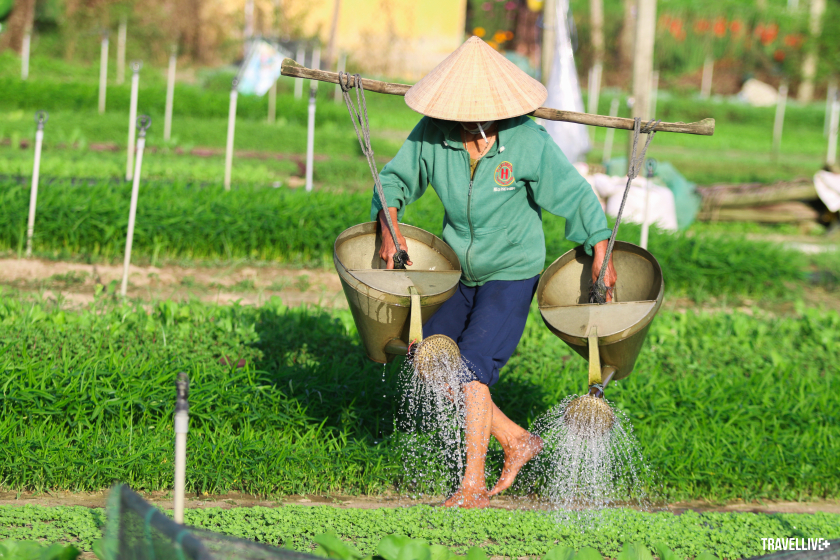
Watering vegetables requires technique.
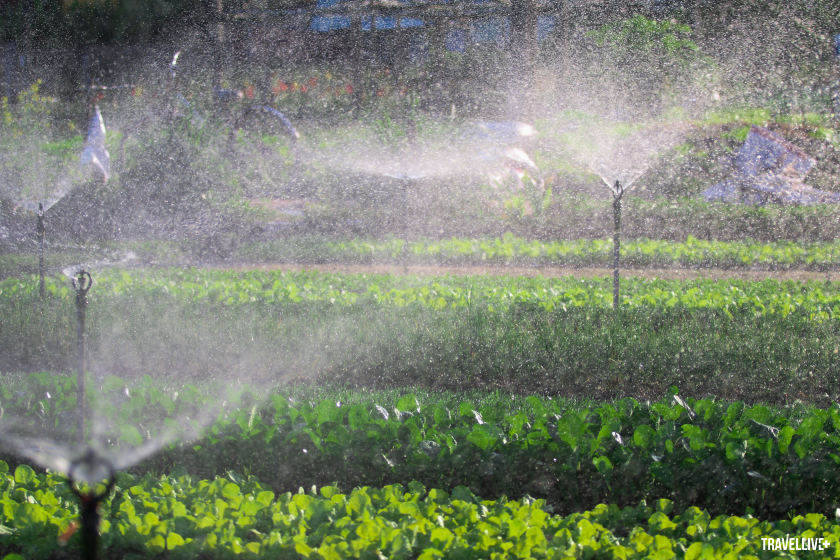
Automatic irrigation system.
Nowadays, besides watering by hand, people have installed automatic watering systems on vegetable beds to save time and labor.
A WARM VEGETABLE CROP
Vegetables bring a cool and fragrant green space to Tra Que. Vegetables from Tra Que land are used in bowls of Quang noodles and Cao Lau. Vegetables also contribute to building a prosperous life for local people. In the days before the pandemic, Tra Que was not only an agricultural production area but also an eco-tourism area, a bustling community of visitors from all over. At its peak, Tra Que could welcome thousands of visitors every day to visit and experience, mainly foreign visitors. They came here, willing to pay to "transform" into farmers.
Since Covid-19 struck, the laughter of tourists has given way to the sounds of everyday life. This is the time for Tra Que to rest and catch its breath. Despite losing its source of income from tourism, the people of Tra Que vegetable village still produce vegetables every day to supply Hoi An and the surrounding areas.
According to the People's Committee of Cam Ha Commune, on average, Tra Que produces 860 tons of vegetables each year, bringing in about 13 billion VND in revenue. After deducting expenses, people earn 8 billion VND. Particularly for the 2022 Lunar New Year vegetable crop, Tra Que supplies 180 tons of vegetables to the market, with a revenue of 2 billion VND. The Tet vegetable crop brings in a profit of 1.4 billion VND to the people.
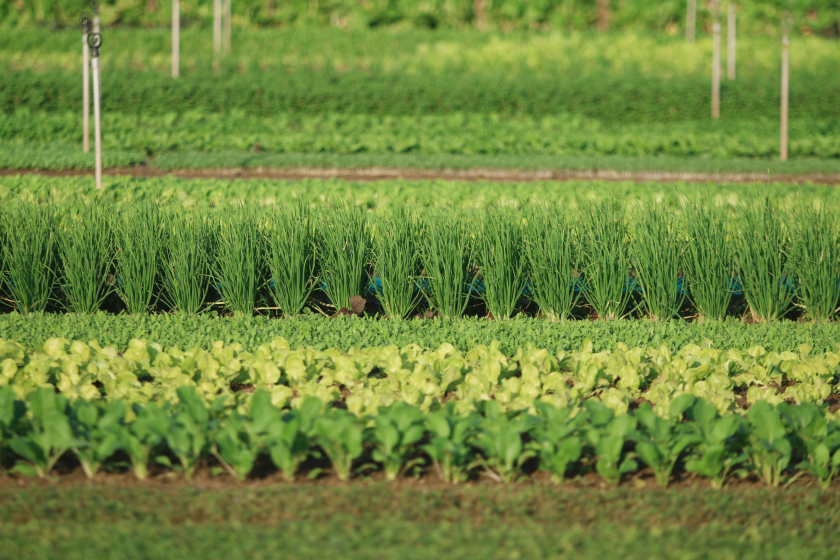
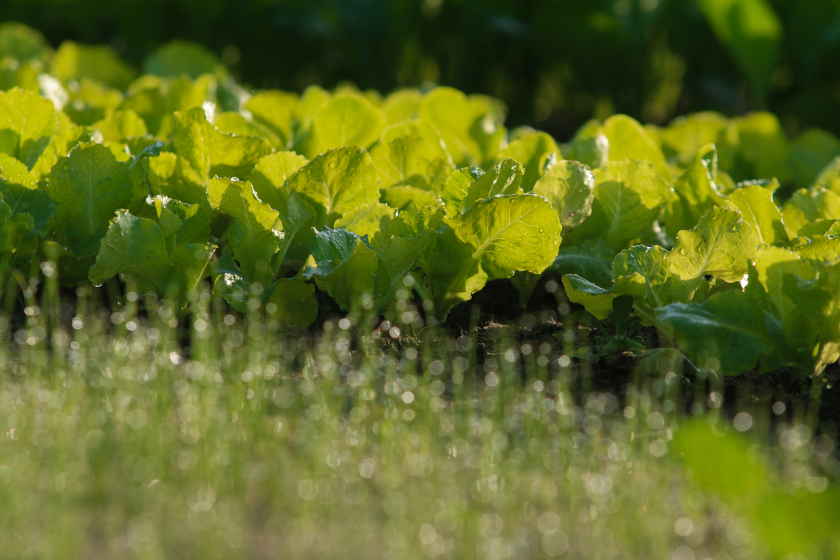
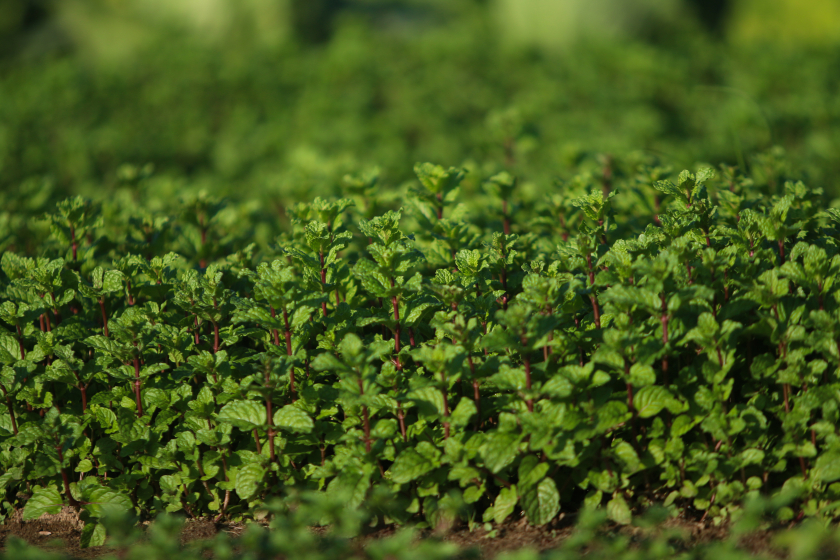
Visitors to Tra Que often want to learn about traditional vegetable growing, or just to breathe the fresh air. Some people come to Tra Que to put their bare feet on the ground and feel the moisture caressing their skin; to plant vegetables in Hoi An soil by themselves as a way to experience the local lifestyle and find their own childhood. Visitors come and go, through the rain and sun, silently through the desolate days of the epidemic, Tra Que vegetables are still green and fragrant like their name, and quietly enter the delicious meals of Quang people.






